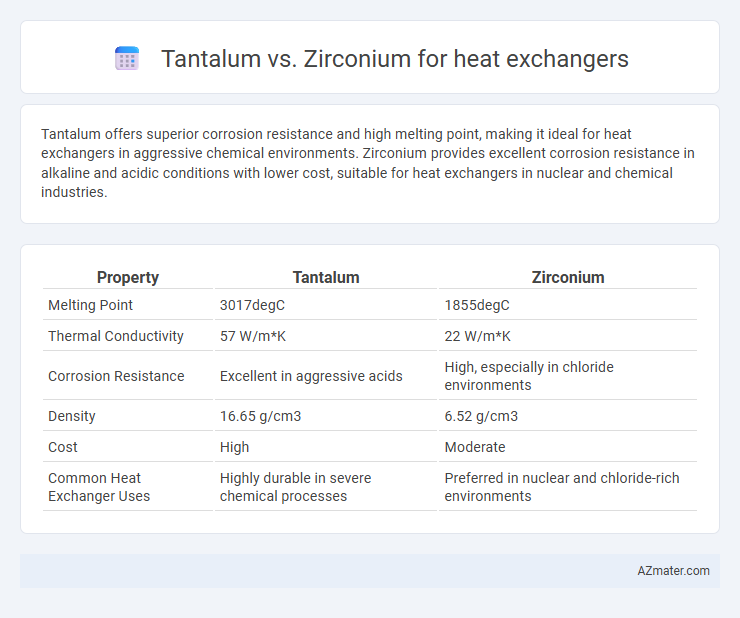Tantalum offers superior corrosion resistance and high melting point, making it ideal for heat exchangers in aggressive chemical environments. Zirconium provides excellent corrosion resistance in alkaline and acidic conditions with lower cost, suitable for heat exchangers in nuclear and chemical industries.
Table of Comparison
| Property | Tantalum | Zirconium |
|---|---|---|
| Melting Point | 3017degC | 1855degC |
| Thermal Conductivity | 57 W/m*K | 22 W/m*K |
| Corrosion Resistance | Excellent in aggressive acids | High, especially in chloride environments |
| Density | 16.65 g/cm3 | 6.52 g/cm3 |
| Cost | High | Moderate |
| Common Heat Exchanger Uses | Highly durable in severe chemical processes | Preferred in nuclear and chloride-rich environments |
Introduction to Tantalum and Zirconium in Heat Exchangers
Tantalum and zirconium are corrosion-resistant metals widely used in heat exchangers for their exceptional chemical stability and high-temperature performance. Tantalum offers superior resistance to aggressive environments, such as acid condensation and chloride-containing fluids, making it ideal for chemical processing applications. Zirconium provides excellent mechanical strength and resistance to stress corrosion cracking, particularly in nuclear reactors and seawater-cooled systems.
Chemical and Physical Properties Comparison
Tantalum exhibits exceptional corrosion resistance against strong acids and high-temperature environments, making it ideal for heat exchangers in aggressive chemical processes. Zirconium offers superior resistance to alkaline media and maintains excellent mechanical strength and ductility at elevated temperatures. Both metals provide high melting points--tantalum at 3017degC and zirconium at 1855degC--while tantalum has higher density (16.69 g/cm3) compared to zirconium (6.52 g/cm3), impacting weight considerations in heat exchanger design.
Corrosion Resistance Capabilities
Tantalum exhibits superior corrosion resistance in aggressive chemical environments, particularly against strong acids such as hydrochloric and sulfuric acid, making it highly suitable for heat exchangers in highly corrosive industrial applications. Zirconium demonstrates excellent resistance to stress corrosion cracking and is effective against caustic alkalis and oxidizing conditions, providing durability in nuclear and chemical processing heat exchangers. The choice between tantalum and zirconium depends on the specific corrosive media, with tantalum favored for acidic resistance and zirconium for alkaline and oxidizing environments.
Thermal Conductivity and Heat Transfer Efficiency
Tantalum offers superior corrosion resistance but has a lower thermal conductivity of approximately 57 W/m*K compared to zirconium's 22 W/m*K, affecting heat transfer efficiency in heat exchangers. Zirconium, with its excellent thermal conductivity and resistance to high-temperature oxidation, provides enhanced heat transfer rates in aggressive environments. Optimizing heat exchanger performance depends on balancing tantalum's corrosion resistance with zirconium's higher thermal conductivity for efficient thermal management.
Mechanical Strength and Durability
Tantalum exhibits superior mechanical strength and exceptional corrosion resistance at high temperatures, making it highly durable for heat exchanger applications in aggressive environments. Zirconium offers excellent mechanical strength combined with remarkable resistance to thermal shock and oxidation, which enhances its lifespan under cyclical temperature changes. Both metals are valued for durability, but tantalum's high melting point (3290degC) and corrosion resistance in acidic conditions often provide an edge in extreme industrial heat exchangers.
Fabrication and Welding Considerations
Tantalum exhibits excellent corrosion resistance and high melting point, making its fabrication for heat exchangers challenging due to its hardness and susceptibility to grain growth during welding, requiring controlled heat input and slow cooling to avoid brittleness. Zirconium, favored for its superior resistance to chloride-induced stress corrosion cracking, allows more straightforward fabrication processes with better weldability, although welding must still be performed under inert atmospheres to prevent contamination and maintain mechanical integrity. Selecting between tantalum and zirconium involves balancing tantalum's corrosion resistance and fabrication complexity against zirconium's ease of welding and resistance to specific corrosive environments.
Cost Analysis and Economic Factors
Tantalum offers superior corrosion resistance in heat exchanger applications but comes at a significantly higher cost compared to zirconium, making initial capital investment a critical factor in material selection. Zirconium provides a cost-effective alternative with good thermal conductivity and adequate chemical resistance, often resulting in lower total lifecycle costs despite potentially shorter service intervals. Evaluating economic factors such as maintenance frequency, expected lifespan, and downtime expenses is essential to determine the most cost-efficient choice between tantalum and zirconium for heat exchanger construction.
Typical Applications in Industry
Tantalum is predominantly used in chemical processing and aerospace industries for heat exchangers due to its exceptional corrosion resistance and ability to withstand high temperatures, especially in aggressive media such as hydrochloric acid. Zirconium finds typical applications in nuclear reactors and marine environments because of its superior corrosion resistance to seawater and neutron transparency, making it ideal for heat exchangers exposed to radioactive or saline conditions. Both metals are chosen based on their specific resistance properties and operational environments, with tantalum favored in highly acidic processes and zirconium in nuclear and seawater applications.
Longevity and Maintenance Requirements
Tantalum heat exchangers exhibit superior longevity due to their exceptional resistance to corrosion and high-temperature stability, making them ideal for highly aggressive chemical environments. Zirconium also offers excellent corrosion resistance but generally requires more frequent maintenance because it is less resistant to acidic and chloride-containing media than tantalum. Maintenance costs for tantalum units tend to be lower over the lifespan of the equipment, as its durability reduces downtime and the need for component replacement.
Choosing the Right Material for Specific Conditions
Tantalum offers exceptional corrosion resistance and high melting points, making it ideal for heat exchangers in highly acidic or oxidizing environments, especially in chemical processing industries. Zirconium provides superior performance in reducing environments and excels at resisting stress corrosion cracking, making it suitable for nuclear reactors and desalination plants. Selecting between tantalum and zirconium depends on the specific chemical composition, temperature range, and pressure conditions of the application to ensure optimal durability and efficiency.

Infographic: Tantalum vs Zirconium for Heat exchanger
 azmater.com
azmater.com